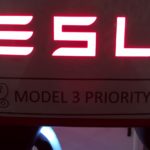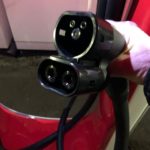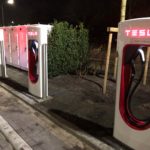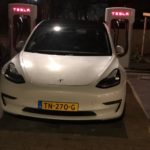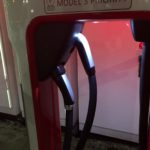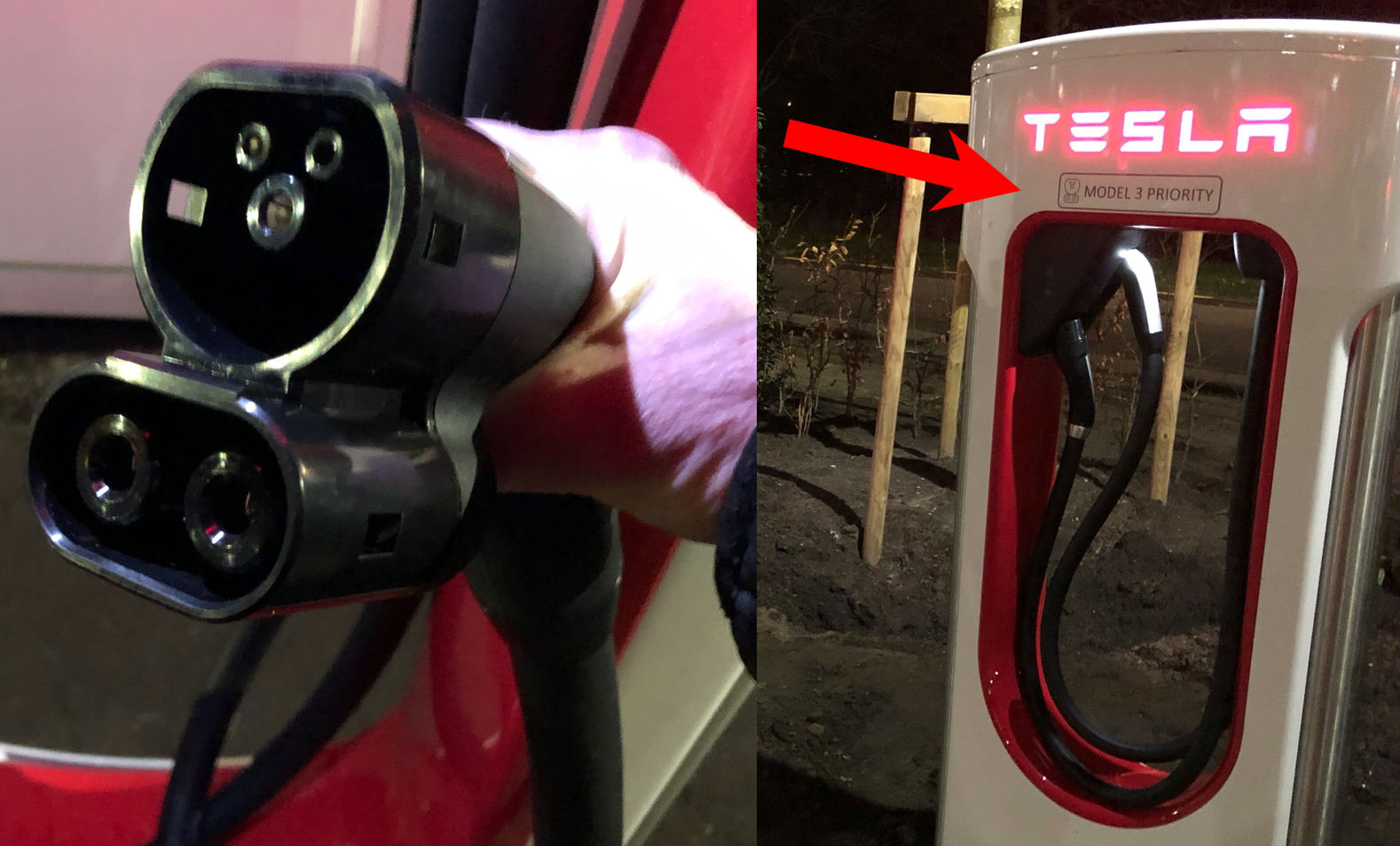
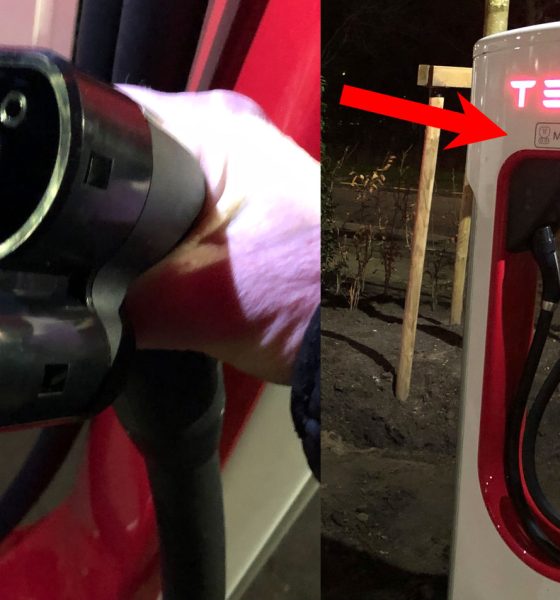
News
Tesla begins Supercharger CCS upgrade ahead of Model 3 rollout in Europe
It is still a couple of months before Model 3 deliveries in Europe are expected to begin, but Tesla is already starting the rollout of dual-charge CCS Superchargers in the region. The company confirmed last month that the Model 3 will be getting a CCS plug for Europe, while a CCS adapter will be introduced for the Model S and X. During its announcement for the Model 3’s charging standard for the region, Tesla noted that it would be “retrofitting our existing Superchargers with dual charge cables to enable Model 3, which will come with a CCS Combo 2 charge port, to use the Tesla Supercharger network.”
Tesla’s adoption of CCS (Combined Charging System) is a notable step for the electric car maker. CCS, after all, is prevalent in the region, being preferred by several European carmakers including BMW, Volkswagen and the Daimler group. The system combines the Type 2 design, which is used for slower AC charging at home or work, as well as with two large DC pins for rapid charging. CCS competes with the CHAdeMO rapid charging standard, which is being used by companies such as Nissan, Mitsubishi and Subaru.
Tesla owner-enthusiast Hans Noordsij visited the site of Tesla’s first dual charge Supercharger station, where he was able to take photos and meet Tesla staff who were working on the updated charging stall. Several details of the upgraded Supercharger were evident from Hans’ images, including a sign indicating that the new stations are “Model 3 Priority.”
- One of Tesla’s first dual-charge, CCS-compatible Superchargers in Europe. (Photo: Hans Noordsij)
- A close-up of Tesla’s CCS plug for the Model 3. (Photo: Hans Noordsij)
- One of Tesla’s first dual-charge, CCS-compatible Superchargers in Europe. (Photo: Hans Noordsij)
One of Tesla’s first dual-charge, CCS-compatible Superchargers in Europe. (Photo: Hans Noordsij)
Speaking to Teslarati after his trip to the Supercharger, Hans noted that Tesla was testing the connection of a Model 3 to the dual charge station when he arrived. Tesla’s staff reportedly informed him that they were aiming to add CCS connectors to every Supercharger in the Netherlands sometime in January.
We reached out to Tesla for more information about its first dual charge CCS Supercharger in Europe. The electric car maker noted that the first upgraded stations are located at the Badhoevedorp Supercharger near the Corendon Village Hotel, just outside Amsterdam. The site currently has 20 Superchargers, and Tesla is installing 8 more stalls on the site, each of which is fitted with both a CCS and a Type 2 connector. When completed, 8 out of the 28 stalls in the location would be compatible with the Model 3, S, and X, while the remaining 20 would be compatible with the flagship sedan and SUV.
Tesla plans to fully retrofit Europe’s Supercharger Network with its dual charge CCS system, allowing the Model 3 to have access to Tesla’s expansive charging infrastructure. While Tesla is in the process of retrofitting its Superchargers with CCS plugs, though, Model 3 owners in the region could expect their vehicles to smartly suggest charging stations that are fitted with the necessary connectors. The location, as well as the availability of these CCS stalls, would be displayed on the Model 3’s display.
- A Tesla Model 3 gets connected to one of Tesla’s first dual-charge, CCS-compatible Superchargers in Europe. (Photo: Hans Noordsij)
- One of Tesla’s first dual-charge, CCS-compatible Superchargers in Europe. (Photo: Hans Noordsij)
- A Tesla Model 3 gets connected to one of Tesla’s first dual-charge, CCS-compatible Superchargers in Europe. (Photo: Hans Noordsij)
A Tesla Model 3 gets connected to one of Tesla’s first dual-charge, CCS-compatible Superchargers in Europe. (Photo: Hans Noordsij)
Europe is a pivotal part of Tesla’s strategy for the Model 3, considering that the premium sedan segment is twice as big in the region as it is in the United States. The Model 3 is already performing well in the US, despite the country being enamored by SUVs and pickup trucks. In a market where sedans are prevalent such Europe, the Model 3’s potential is vast.
Considering that Tesla is now rolling out CCS plugs on its European Supercharger Network, the idea of Tesla sharing its charging infrastructure with other electric cars emerges once more. Tesla’s head of global charging infrastructure, Drew Bennett, addressed this in an interview with Auto Express UK, where he noted that several EV makers have already reached out to Tesla about sharing the Supercharger Network.
“We’re definitely open to talking to other car manufacturers who want to have access to the network. Capacity is a driver for our investment; it’s new routes, new markets and then capacity. A lot of car makers have spoken to us about it, but we haven’t had any conclusive discussions on it. They’re still trying to figure out what they would need in a network, but we’re a couple of years ahead of them in terms of embracing the investment required to transition to EVs,” Bennett said.

News
Tesla FSD fleet is nearing 7 billion total miles, including 2.5 billion city miles
As can be seen on Tesla’s official FSD webpage, vehicles equipped with the system have now navigated over 6.99 billion miles.

Tesla’s Full Self-Driving (Supervised) fleet is closing in on almost 7 billion total miles driven, as per data posted by the company on its official FSD webpage.
These figures hint at the massive scale of data fueling Tesla’s rapid FSD improvements, which have been quite notable as of late.
FSD mileage milestones
As can be seen on Tesla’s official FSD webpage, vehicles equipped with the system have now navigated over 6.99 billion miles. Tesla owner and avid FSD tester Whole Mars Catalog also shared a screenshot indicating that from the nearly 7 billion miles traveled by the FSD fleet, more than 2.5 billion miles were driven inside cities.
City miles are particularly valuable for complex urban scenarios like unprotected turns, pedestrian interactions, and traffic lights. This is also the difference-maker for FSD, as only complex solutions, such as Waymo’s self-driving taxis, operate similarly on inner-city streets. And even then, incidents such as the San Francisco blackouts have proven challenging for sensor-rich vehicles like Waymos.
Tesla’s data edge
Tesla has a number of advantages in the autonomous vehicle sector, one of which is the size of its fleet and the number of vehicles training FSD on real-world roads. Tesla’s nearly 7 billion FSD miles then allow the company to roll out updates that make its vehicles behave like they are being driven by experienced drivers, even if they are operating on their own.
So notable are Tesla’s improvements to FSD that NVIDIA Director of Robotics Jim Fan, after experiencing FSD v14, noted that the system is the first AI that passes what he described as a “Physical Turing Test.”
“Despite knowing exactly how robot learning works, I still find it magical watching the steering wheel turn by itself. First it feels surreal, next it becomes routine. Then, like the smartphone, taking it away actively hurts. This is how humanity gets rewired and glued to god-like technologies,” Fan wrote in a post on X.
News
Tesla starts showing how FSD will change lives in Europe
Local officials tested the system on narrow country roads and were impressed by FSD’s smooth, human-like driving, with some calling the service a game-changer for everyday life in areas that are far from urban centers.

Tesla has launched Europe’s first public shuttle service using Full Self-Driving (Supervised) in the rural Eifelkreis Bitburg-Prüm region of Germany, demonstrating how the technology can restore independence and mobility for people who struggle with limited transport options.
Local officials tested the system on narrow country roads and were impressed by FSD’s smooth, human-like driving, with some calling the service a game-changer for everyday life in areas that are far from urban centers.
Officials see real impact on rural residents
Arzfeld Mayor Johannes Kuhl and District Administrator Andreas Kruppert personally tested the Tesla shuttle service. This allowed them to see just how well FSD navigated winding lanes and rural roads confidently. Kruppert said, “Autonomous driving sounds like science fiction to many, but we simply see here that it works totally well in rural regions too.” Kuhl, for his part, also noted that FSD “feels like a very experienced driver.”
The pilot complements the area’s “Citizen Bus” program, which provides on-demand rides for elderly residents who can no longer drive themselves. Tesla Europe shared a video of a demonstration of the service, highlighting how FSD gives people their freedom back, even in places where public transport is not as prevalent.
What the Ministry for Economic Affairs and Transport says
Rhineland-Palatinate’s Minister Daniela Schmitt supported the project, praising the collaboration that made this “first of its kind in Europe” possible. As per the ministry, the rural rollout for the service shows FSD’s potential beyond major cities, and it delivers tangible benefits like grocery runs, doctor visits, and social connections for isolated residents.
“Reliable and flexible mobility is especially vital in rural areas. With the launch of a shuttle service using self-driving vehicles (FSD supervised) by Tesla in the Eifelkreis Bitburg-Prüm, an innovative pilot project is now getting underway that complements local community bus services. It is the first project of its kind in Europe.
“The result is a real gain for rural mobility: greater accessibility, more flexibility and tangible benefits for everyday life. A strong signal for innovation, cooperation and future-oriented mobility beyond urban centers,” the ministry wrote in a LinkedIn post.
News
Tesla China quietly posts Robotaxi-related job listing
Tesla China is currently seeking a Low Voltage Electrical Engineer to work on circuit board design for the company’s autonomous vehicles.

Tesla has posted a new job listing in Shanghai explicitly tied to its Robotaxi program, fueling speculation that the company is preparing to launch its dedicated autonomous ride-hailing service in China.
As noted in the listing, Tesla China is currently seeking a Low Voltage Electrical Engineer to work on circuit board design for the company’s autonomous vehicles.
Robotaxi-specific role
The listing, which was shared on social media platform X by industry watcher @tslaming, suggested that Tesla China is looking to fill the role urgently. The job listing itself specifically mentions that the person hired for the role will be working on the Low Voltage Hardware team, which would design the circuit boards that would serve as the nervous system of the Robotaxi.
Key tasks for the role, as indicated in the job listing, include collaboration with PCB layout, firmware, mechanical, program management, and validation teams, among other responsibilities. The role is based in Shanghai.
China Robotaxi launch
China represents a massive potential market for robotaxis, with its dense urban centers and supportive policies in select cities. Tesla has limited permission to roll out FSD in the country, though despite this, its vehicles have been hailed as among the best in the market when it comes to autonomous features. So far, at least, it appears that China supports Tesla’s FSD and Robotaxi rollout.
This was hinted at in November, when Tesla brought the Cybercab to the 8th China International Import Expo (CIIE) in Shanghai, marking the first time that the autonomous two-seater was brought to the Asia-Pacific region. The vehicle, despite not having a release date in China, received a significant amount of interest among the event’s attendees.
